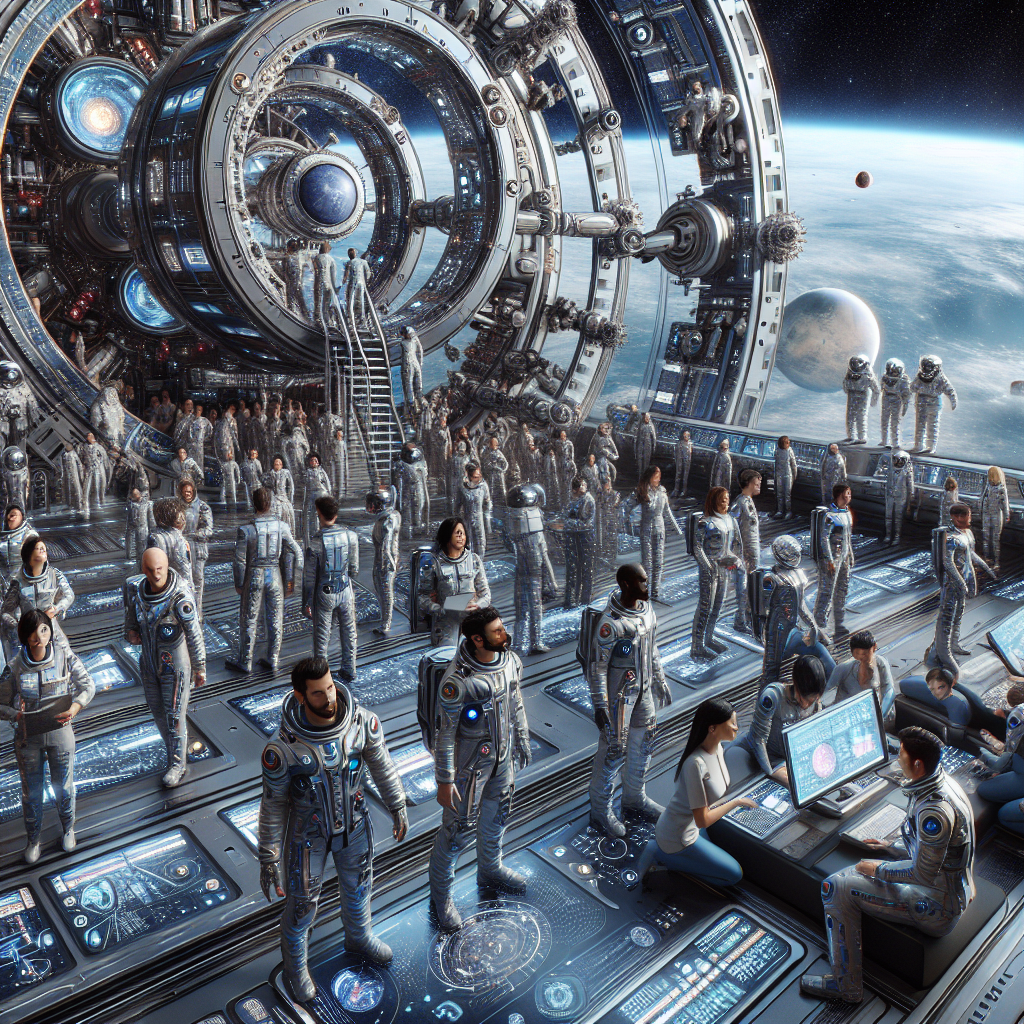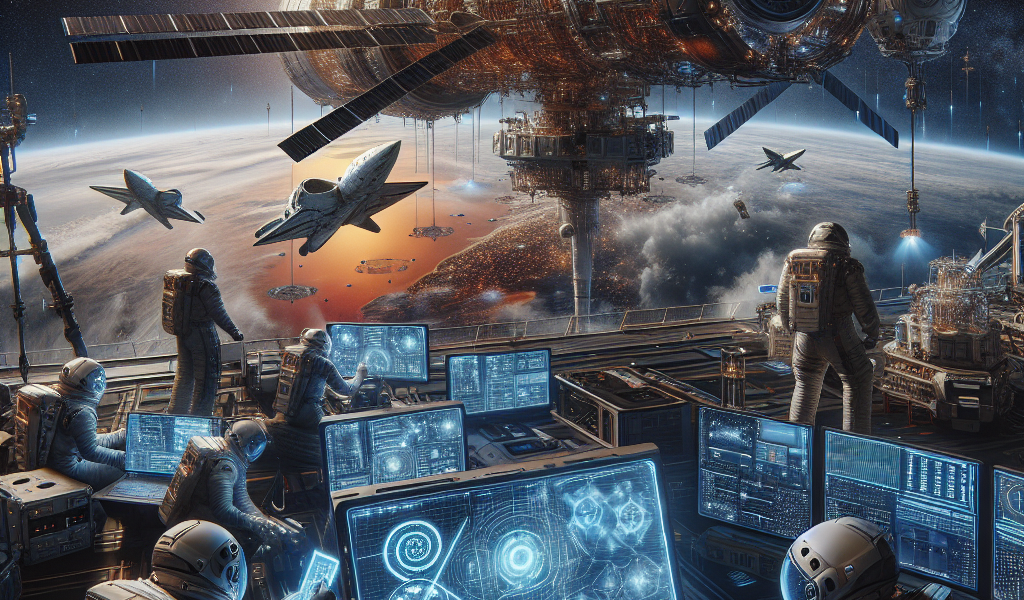-
Table of Contents
“Charting New Frontiers: The Future of Space Exploration Through Technological Innovation”
Introduction

The future of space exploration is poised to undergo a transformative evolution, driven by groundbreaking advances in technology. As humanity’s quest to explore the cosmos intensifies, innovations in propulsion systems, robotics, artificial intelligence, and sustainable life support systems are revolutionizing our approach to space travel. These technological advancements are not only enhancing our ability to reach farther into the universe but also improving the efficiency, safety, and feasibility of long-duration missions. From the development of reusable rockets to the deployment of sophisticated space telescopes and the potential colonization of other planets, the next era of space exploration promises to unlock new frontiers and expand our understanding of the universe.
Innovations in Spacecraft Design: Paving the Way for Deep Space Missions
The future of space exploration is being shaped by remarkable advances in technology, particularly in the realm of spacecraft design. These innovations are not only making space travel more efficient but also paving the way for ambitious deep space missions that were once the stuff of science fiction. As we stand on the brink of a new era in space exploration, it is fascinating to see how these technological breakthroughs are transforming our capabilities and expanding our horizons.
One of the most significant advancements in spacecraft design is the development of more efficient propulsion systems. Traditional chemical rockets, while powerful, are limited by their fuel efficiency and the sheer amount of propellant required for long-duration missions. In contrast, new propulsion technologies such as ion thrusters and nuclear thermal propulsion offer the promise of greater efficiency and longer operational lifespans. Ion thrusters, for instance, use electric fields to accelerate ions and produce thrust, allowing spacecraft to travel farther and faster with less fuel. This technology has already been successfully demonstrated in missions like NASA’s Dawn spacecraft, which explored the asteroid belt.
In addition to propulsion, the materials used in spacecraft construction are undergoing a revolution. Lightweight, high-strength materials such as carbon composites and advanced alloys are replacing traditional metals, reducing the overall mass of spacecraft and increasing their durability. These materials not only enhance the performance of spacecraft but also contribute to the feasibility of deep space missions by allowing for larger payloads and more robust structures. Moreover, the advent of 3D printing technology is enabling the on-demand production of spacecraft components, which can be particularly useful for in-situ resource utilization on missions to the Moon or Mars.
Another critical area of innovation is in the design of life support systems. For deep space missions, maintaining a stable and habitable environment for astronauts over extended periods is paramount. Advances in closed-loop life support systems, which recycle air, water, and waste, are making it possible to sustain human life in space for longer durations. NASA’s Environmental Control and Life Support System (ECLSS), for example, has been a key component of the International Space Station, and its technologies are being refined for future missions to Mars.
Furthermore, the integration of artificial intelligence (AI) and automation in spacecraft design is revolutionizing mission operations. AI can assist in navigation, system diagnostics, and even decision-making processes, reducing the workload on human astronauts and increasing the efficiency of missions. Autonomous spacecraft, capable of performing complex tasks without direct human intervention, are becoming a reality. This capability is particularly crucial for deep space missions, where communication delays with Earth can hinder real-time decision-making.
The development of modular spacecraft is another exciting innovation. Modular designs allow for the assembly of spacecraft in orbit, enabling the construction of larger and more versatile structures than would be possible to launch in a single piece. This approach not only enhances the flexibility of mission planning but also opens up new possibilities for international collaboration, as different countries can contribute modules to a shared mission.
As we look to the future, it is clear that these advances in spacecraft design are laying the groundwork for humanity’s next great leap into the cosmos. With each technological breakthrough, we move closer to realizing the dream of deep space exploration, from establishing lunar bases to sending crewed missions to Mars and beyond. The journey is just beginning, and the innovations in spacecraft design are lighting the way.
The Role of Artificial Intelligence in Enhancing Space Exploration Capabilities
The future of space exploration is being shaped by rapid advances in technology, and at the forefront of these developments is artificial intelligence (AI). As humanity sets its sights on more ambitious missions, from returning to the Moon to exploring Mars and beyond, AI is playing an increasingly pivotal role in enhancing our capabilities to navigate and understand the cosmos. This transformative technology is not only making space missions more efficient but also enabling us to tackle challenges that were previously insurmountable.
One of the most significant ways AI is contributing to space exploration is through autonomous navigation. Spacecraft equipped with AI can make real-time decisions without waiting for instructions from Earth, which is crucial given the vast distances involved. For instance, the Mars rovers, such as Curiosity and Perseverance, use AI to autonomously navigate the Martian terrain, avoiding obstacles and selecting optimal paths. This autonomy allows them to cover more ground and conduct more scientific experiments than would be possible if they relied solely on commands from mission control.
In addition to navigation, AI is revolutionizing the way we process and analyze the massive amounts of data generated by space missions. Satellites and telescopes capture vast quantities of information, far more than human scientists could ever hope to analyze manually. AI algorithms can sift through this data, identifying patterns and anomalies that might otherwise go unnoticed. This capability is particularly valuable in the search for exoplanets, where AI has been instrumental in identifying potential candidates for further study.
Moreover, AI is enhancing the design and operation of spacecraft. Machine learning algorithms can optimize the design of spacecraft components, making them more efficient and reliable. During missions, AI can monitor the health of spacecraft systems, predicting and diagnosing potential issues before they become critical. This predictive maintenance is essential for long-duration missions, where the ability to address problems proactively can mean the difference between success and failure.
The role of AI extends beyond the hardware and software of space missions to include the human element as well. Astronauts on long-duration missions face numerous challenges, from physical health issues to psychological stress. AI-driven systems can provide support in these areas, offering personalized health monitoring and mental health resources. For example, virtual assistants powered by AI can help astronauts manage their schedules, troubleshoot technical issues, and even provide companionship during the long, isolated stretches of space travel.
Furthermore, AI is playing a crucial role in the development of new propulsion systems and energy sources, which are vital for reaching distant destinations. By simulating and optimizing various propulsion technologies, AI can help engineers develop more efficient engines that can reduce travel time and fuel consumption. This progress is essential for making interplanetary travel more feasible and sustainable.
As we look to the future, the integration of AI in space exploration promises to unlock new possibilities and expand our understanding of the universe. The synergy between human ingenuity and artificial intelligence is creating a new era of exploration, where the boundaries of what we can achieve are continually being pushed. While challenges remain, the advancements in AI are providing us with the tools to overcome them, paving the way for a future where space exploration is not just the domain of a few highly trained astronauts but a shared endeavor that benefits all of humanity.
Breakthroughs in Propulsion Systems: Faster and More Efficient Space Travel
The future of space exploration is poised for a revolution, driven by groundbreaking advances in propulsion systems that promise faster and more efficient space travel. As humanity sets its sights on distant planets and even interstellar destinations, the need for innovative propulsion technologies has never been more critical. Traditional chemical rockets, while reliable, are limited by their relatively low efficiency and high fuel consumption. However, recent developments in propulsion systems are set to overcome these limitations, opening up new possibilities for space exploration.
One of the most promising advancements in this field is the development of ion propulsion systems. Unlike conventional rockets that rely on the combustion of chemical propellants, ion thrusters use electricity to ionize a propellant, typically xenon, and then accelerate the ions to generate thrust. This method is significantly more efficient, allowing spacecraft to achieve higher speeds over longer durations. NASA’s Dawn mission, which explored the asteroid belt, demonstrated the potential of ion propulsion by traveling vast distances with minimal fuel consumption. As researchers continue to refine this technology, future missions could see even greater improvements in speed and efficiency.
In addition to ion propulsion, another exciting development is the advent of nuclear thermal propulsion (NTP). This technology leverages the heat generated by nuclear reactions to superheat a propellant, such as hydrogen, which is then expelled to produce thrust. NTP systems offer a substantial increase in efficiency compared to chemical rockets, potentially reducing travel time to Mars by half. The shorter journey not only makes manned missions more feasible but also reduces the risks associated with prolonged exposure to space radiation. With NASA and private companies like SpaceX investing in NTP research, the dream of a manned mission to Mars is becoming increasingly tangible.
Moreover, the concept of solar sails is gaining traction as a viable propulsion method for deep space exploration. Solar sails harness the pressure exerted by sunlight on large, reflective surfaces to propel a spacecraft. While the initial acceleration is slow, solar sails can achieve remarkable speeds over time without the need for fuel. The Japanese space agency JAXA successfully tested this technology with its IKAROS mission, which demonstrated the potential for solar sails to enable long-duration missions to the outer reaches of our solar system and beyond. As materials science advances, the efficiency and durability of solar sails are expected to improve, making them a key player in the future of space travel.
Furthermore, the development of fusion propulsion systems holds the promise of unprecedented speeds and efficiency. Fusion propulsion aims to replicate the processes that power the sun, using nuclear fusion reactions to generate immense amounts of energy. While still in the experimental stage, fusion propulsion could theoretically enable spacecraft to reach speeds close to a significant fraction of the speed of light, making interstellar travel a possibility. Companies like Helion Energy and research institutions worldwide are making strides in this area, bringing us closer to a future where humanity can explore beyond our solar system.
As these advanced propulsion systems continue to evolve, they will undoubtedly transform the landscape of space exploration. The ability to travel faster and more efficiently will not only make distant planets and moons more accessible but also pave the way for new scientific discoveries and potential colonization efforts. The synergy between public space agencies and private enterprises is accelerating the pace of innovation, ensuring that the next frontier of space exploration is within our grasp. With each breakthrough, we move one step closer to realizing the dream of becoming a multi-planetary species, exploring the cosmos with unprecedented speed and efficiency.
Conclusion
The future of space exploration is poised for remarkable advancements driven by cutting-edge technology. Innovations in propulsion systems, robotics, artificial intelligence, and materials science are enabling more efficient and ambitious missions. Private sector involvement and international collaborations are accelerating progress, making space more accessible. As technology continues to evolve, humanity is on the brink of unprecedented discoveries and the potential for sustainable extraterrestrial habitats, marking a new era in our quest to explore and understand the cosmos.





